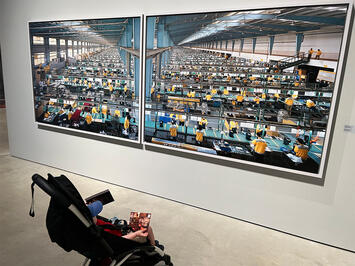
I recently experienced Edward Burtynsky’s The Great Acceleration at New York’s International Center of Photography—and it was nothing short of remarkable. This is Burtynsky’s first major institutional show in New York City in over two decades, spanning more than seventy photographs, including monumental murals and rarely seen early works. Curated with surgical precision by ICP’s creative director David Campany, the exhibition is both a retrospective and a provocation.
Burtynsky has spent nearly fifty years documenting the vast imprint of industrial civilization—from open pit mines in North America to e-waste sites in China and oil infrastructure in Azerbaijan. The exhibition, timed to coincide with Climate Week NYC, reads as both a visual history of global transformation and an urgent meditation on the consequences of unrestrained human activity.
What struck me most was how Burtynsky uses beauty and scale to deliver a warning. His images—sweeping views of irrigation systems, scarred expanses of mining sites, orchards of shipping containers—are breathtaking in their composition, texture, and color. Yet each is also a ledger of environmental depletion and human ambition pushed to the brink.
Take, for instance, a 28-by-28-foot mural of pivot irrigation in the Texas High Plains. From above, the circular plots resemble abstract graphics—perfect geometry and muted tones—until you spot the tiny farmhouses and irrigation arms draining the Ogallala Aquifer. It’s both sublime and devastating: agriculture’s elegance set against planetary cost.
Or consider Dry Tailings #1 from the Congo, which zooms in on a cobalt mine’s tailings pond. Its reds and ochres evoke abstract painting—until you notice the minuscule human figures combing through the toxic sludge. Suddenly, the image transforms from aesthetic marvel to sobering window into the hidden costs of global consumerism.
Burtynsky’s aerial compositions—taken via helicopter, drone, or elevated terrain—deliberately remove us from first-person sympathy. We’re not immersed; we’re distanced, forced into the role of planetary witness. As sociologist Zygmunt Bauman might suggest, this detachment is a hallmark of modernity itself: systems so vast that they dissolve individual responsibility. Yet that detachment is precisely what these images disrupt.
Still, The Great Acceleration avoids the trap of “landscape porn.” It includes intimate portraits of workers in mines, shipbreaking yards, and factories. These quieter moments ground the scale of the industrial sublime in human reality—underscoring that environmental systems are also economic and moral systems.
National Geographic once described Burtynsky’s perspective as that of an “alien observer”—a distant intelligence reporting on human civilization. That’s apt. His photographs don’t lecture. They reveal. And that revelation—of scale, of complexity, of consequence—invites reflection, not ideology.
In fact, The Great Acceleration builds on the coherence of Burtynsky’s earlier landmark projects like Manufactured Landscapes and Anthropocene, but here, the synthesis is tighter and more direct to the audience. We traverse mining pits, suburban sprawl, irrigation networks, oil fields, and recycling centers—each frame a chapter in the human reshaping of Earth. The show isn’t fragmented; it’s a visual essay.
So what does it all mean?
In my view and first, scale matters. Climate change, resource depletion, waste accumulation—these are not abstract or distant problems. Burtynsky’s aerial vantage and mural scale compel us to confront their magnitude. Second, beauty can be disruptive. His images seduce with form, but then provoke with content. This is not moralism dressed up as art. It’s moral inquiry embedded in visual tension—between seduction and unease, distance and responsibility. Third and finally, urgency is implicit. The exhibition does not shout. It slows us down. It teaches us to see. The inclusion of a recent image of the Palisades wildfire aftermath—hung by the ICP gift desk like a quiet warning—makes the stakes painfully current. Climate disruption is no longer confined to faraway wastelands. It’s here and it is very real.
The exhibition’s ethical resonance echoes Wendell Berry’s warning from 1977: “The earth is what we all have in common.” For Berry, land is not merely backdrop but inheritance—an inheritance degraded when treated as commodity rather than community. Burtynsky’s work, like Berry’s writing, calls us back to responsibility, not through guilt but through vision.
In short, The Great Acceleration isn’t just photography. It’s a meditation on human agency, environmental cost, and visual citizenship in the Anthropocene. It reminds us that the systems we’ve built—oil wells, aqueducts, shipping routes, neighborhoods—are not just infrastructure. They are stories. They encode decisions, tradeoffs, inequities.
For those of us in policy, academia, or theology, Burtynsky offers a quiet rebuke: stewardship must matter more than spectacle. Innovation without humility leads to exhaustion. And faith in progress without moral limits is no faith at all.
In an era saturated with imagery—where Instagram delivers an endless scroll of drone shots, vacation vistas, and algorithmically curated #earthporn—Burtynsky still manages to shock, surprise, and connect. That’s because his work isn’t just aesthetic spectacle. It’s about scale—geographic, ecological, and moral. His ability to render vast, human-altered landscapes both legible and emotionally resonant sets him apart in a visually overloaded culture. Despite our global connectivity and access to travel, we rarely see the infrastructural systems that sustain modern life. Burtynsky forces that confrontation. His images reveal how oil flows, minerals move, food is irrigated, and waste accumulates. And in doing so, they cut through the noise of digital ephemera to deliver something rare: awe and reckoning.
Samuel J. Abrams is a professor of politics at Sarah Lawrence College and a nonresident senior fellow at the American Enterprise Institute.
Photo: courtesy the author.












